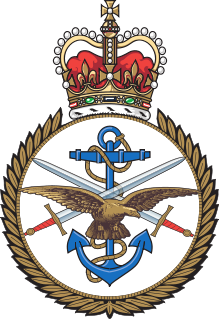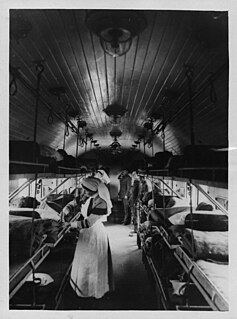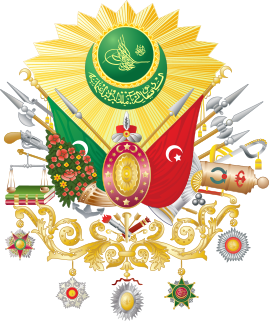
The British Army is the principal land warfare force of the United Kingdom, a part of the British Armed Forces along with the Royal Navy and the Royal Air Force. As of 2021, the British Army comprises 82,230 regular full-time personnel and 30,030 reserve personnel.

The British Armed Forces, also known as Her Majesty's Armed Forces, are the military services responsible for the defence of the United Kingdom, its overseas territories and the Crown dependencies. They also promote the UK's wider interests, support international peacekeeping efforts and provide humanitarian aid.

The British Indian Army, commonly referred to as the Indian Army, was the main military of the British Indian Empire before its decommissioning in 1947. It was responsible for the defence of both the British Indian Empire and the princely states, which could also have their own armies. The Indian Army was an important part of the British Empire's forces, both in India and abroad, particularly during the First World War and the Second World War.

The 93rd Infantry Division was a "colored" segregated unit of the United States Army in World War I and World War II. However, in World War I only its four infantry regiments, two brigade headquarters, and a provisional division headquarters were organized, and the divisional and brigade headquarters were demobilized in May 1918. Its regiments fought primarily under French command in that war. During tough combat in France, they soon acquired from the French the nickname Blue Helmets, as these units were issued blue French Adrian helmets. This referred to the service of several of its units with the French Army during the Second Battle of the Marne. Consequently, its shoulder patch became a blue French helmet, to commemorate its service with the French Army during the German spring offensive.

In Great Britain just before World War I there were 24 million adult women and 1.7 million worked in domestic service, 200,000 worked in the textile manufacturing industry, 600,000 worked in the clothing trades, 500,000 worked in commerce, and 260,000 worked in local and national government, including teaching. The British textile and clothing trades, in particular, employed far more women than men and were regarded as 'women's work'. During WWII, in total, 6 million women were added to the workforce in what resulted as a major cultural shift. With the men fighting in the wars, women were needed to take on responsibilities that the men had to leave behind.

The pith helmet also known as the safari helmet, sun helmet, topee, sola topee, topi, salacot, or salakof, is a lightweight cloth-covered helmet made of sholapith. The pith helmet originates from the Spanish adaptation of the native salakot headgear of the Philippines.

The Women's Army Corps (WAC) was the women's branch of the United States Army. It was created as an auxiliary unit, the Women's Army Auxiliary Corps (WAAC) on 15 May 1942 by Pub.L. 77–554, and converted to an active duty status in the Army of the United States as the WAC on 1 July 1943. Its first director was Oveta Culp Hobby, a prominent woman in Texas society. The WAC was disbanded in 1978, and all units were integrated with male units.

Auxiliaries are support personnel that assist the military or police but are organised differently from regular forces. Auxiliary may be military volunteers undertaking support functions or performing certain duties such as garrison troops, usually on a part-time basis. Unlike a military reserve force, an auxiliary force does not necessarily have the same degree of training or ranking structure as regular soldiers, and may or may not be integrated into a fighting force. Some auxiliaries however are militias composed of former active duty military personnel and actually have better training and combat experience than their regular counterparts.

The Military Auxiliary Radio System (MARS) is a United States Department of Defense sponsored program, established as a separately managed and operated program by the United States Army, and the United States Air Force. The United States Navy-Marine Corps program closed in 2015. The program is a civilian auxiliary consisting primarily of licensed amateur radio operators who are interested in assisting the military with communications on a regional and national level when access to traditional forms of communication may no longer be available. The MARS programs also include active duty, reserve, and National Guard units; and Navy, Marine Corps units.

The Royal Army Pay Corps (RAPC) was the corps of the British Army responsible for administering all financial matters. It was amalgamated into the Adjutant General's Corps in 1992.

The Solomon Islands campaign was a major campaign of the Pacific War of World War II. The campaign began with Japanese landings and occupation of several areas in the British Solomon Islands and Bougainville, in the Territory of New Guinea, during the first six months of 1942. The Japanese occupied these locations and began the construction of several naval and air bases with the goals of protecting the flank of the Japanese offensive in New Guinea, establishing a security barrier for the major Japanese base at Rabaul on New Britain, and providing bases for interdicting supply lines between the Allied powers of the United States and Australia and New Zealand.

Henderson Field is a former military airfield on Guadalcanal, Solomon Islands during World War II. Originally built by the Japanese Empire, the conflict over its possession was one of the great battles of the Pacific War. Today it is Honiara International Airport.

Australia entered World War II on 3 September 1939, following the government's acceptance of the United Kingdom's declaration of war on Nazi Germany. Australia later entered into a state of war with other members of the Axis powers, including the Kingdom of Italy on 11 June 1940, and the Empire of Japan on 9 December 1941. By the end of the war, almost a million Australians had served in the armed forces, whose military units fought primarily in the European theatre, North African campaign, and the South West Pacific theatre. In addition, Australia came under direct attack for the first time in its post-colonial history. Its casualties from enemy action during the war were 27,073 killed and 23,477 wounded. Many more suffered from tropical disease, hunger, and harsh conditions in captivity: of the 21,467 Australian prisoners taken by the Japanese only 14,000 survived.

The Royal Pioneer Corps was a British Army combatant corps used for light engineering tasks. It was formed in 1939, and amalgamated into the Royal Logistic Corps in 1993. Pioneer units performed a wide variety of tasks in all theatres of war, including full infantry, mine clearance, guarding bases, laying prefabricated track on beaches, and effecting various logistical operations. With the Royal Engineers they constructed airfields and roads and erected bridges; they constructed the Mulberry Harbour and laid the Pipe Line Under the Ocean (PLUTO).
A pioneer is a soldier employed to perform engineering and construction tasks. The term is in principle similar to sapper or combat engineer.

Women in the Second World War took on many different roles during the War, including as combatants and workers on the home front. The Second World War involved global conflict on an unprecedented scale; the absolute urgency of mobilizing the entire population made the expansion of the role of women inevitable, although the particular roles varied from country to country. Millions of women of various ages were injured or died as a result of the war.

The Ottoman Army was the army of the Ottoman Empire after the country was reorganized along modern western European lines during the Tanzimat modernization period. It operated during the decline and dissolution of the empire, which roughly occurred between 1861 and 1918, the end of World War I for the Ottomans. The Crimean War was the first war effort in which the modern army took part, proving itself as a decent force. The last reorganization occurred during the Second Constitutional Era.

The Indian Army Pioneer Corps or Pioneers is the operational logistics arm of the Indian Army. Though not a combat arm, the Pioneer Corps provide disciplined and well trained manpower where civilian labour is either not available or its employment is not desirable for reasons of security. Pioneer units are mostly committed in forward and operational areas. Although the Pioneer Corps were at one time the third largest troop in the Army and had a total of 26 Pioneer Companies even till 1999, today there are 21 Pioneer Units under various commands. The Pioneer Corps Training Center (PCTC) is currently located in Bangalore.

The Vanuatu Labor Corps was a labour unit of the United States Armed Forces consisting of New Hebrides natives. The unit was established in 1942 and dissolved in 1945. During its service it provided crucial logistical support to the Allied war effort during the Guadalcanal Campaign. It was jointly led by Major George Riser and Thomas Beatty, while its size fluctuated between 1,000 and 10,000 men.

The African Auxiliary Pioneer Corps (AAPC) was a unit of the British Army consisting of High Commission Territories (HCT) natives. The AAPC was established in July 1941, after the paramount chiefs of the HCT managed to convince the colonial authorities to create an independent force consisting of their subjects. During its service it provided crucial logistical support to the Allied war effort during the North African, Dodecanese and Italian campaigns. Initially a labor unit, AAPC's duties were gradually expanded to include anti-aircraft artillery operation and other combat duties. It was commanded by Colonel H. G. L. Prynne and numbered 36,000 men, 1,216 of whom died in the war. The last AAPC soldiers were repatriated in spring 1946 and the unit was disbanded in 1949.


















